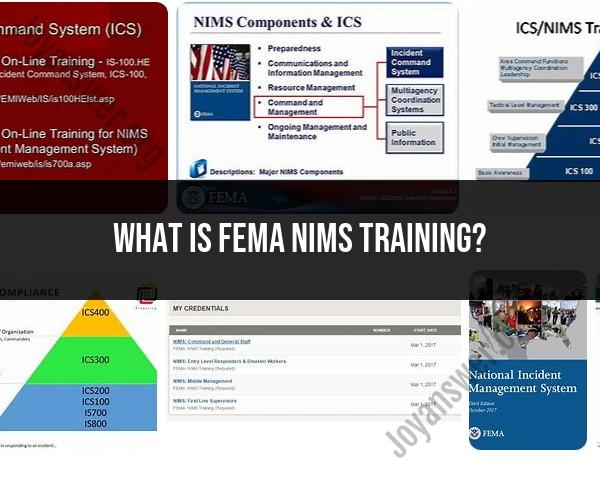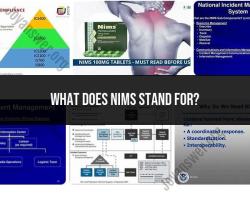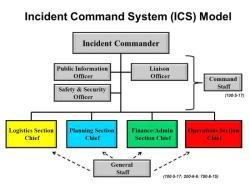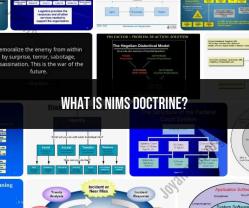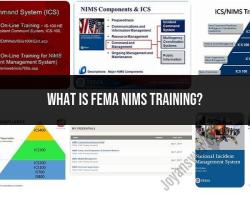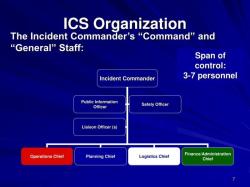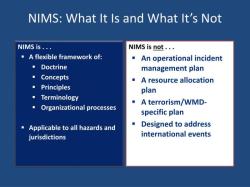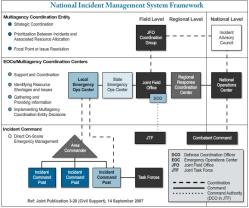What is FEMA NIMS training?
FEMA NIMS training refers to courses and educational programs provided by the Federal Emergency Management Agency (FEMA) related to the National Incident Management System (NIMS). NIMS is a comprehensive framework designed to enhance the nation's ability to respond to and manage incidents, including natural disasters, emergencies, and other crises. The primary goal of NIMS is to improve coordination and collaboration among various agencies and organizations involved in emergency response and management.
Key components of FEMA NIMS training include:
Introduction to NIMS:
- Courses that provide an overview of the NIMS framework, its principles, and its significance in ensuring a coordinated and effective response to incidents.
Basic Incident Command System (ICS):
- ICS is a critical component of NIMS. Training in the Basic ICS introduces participants to the structure, functions, and principles of ICS, which is a standardized management system used for incident response.
Intermediate Incident Command System (ICS):
- More advanced training in ICS builds on the basic principles and delves deeper into the organizational structure, roles, and responsibilities within an incident management team.
Emergency Operations Center (EOC) Training:
- Courses focused on the functions and operations of Emergency Operations Centers, which serve as command and coordination centers during incidents.
Multi-Agency Coordination (MAC) System:
- Training related to the coordination and collaboration among various agencies and organizations involved in incident response. MAC System training emphasizes effective communication and resource sharing.
Joint Information System (JIS):
- JIS training focuses on establishing and maintaining a coordinated public information system during incidents. This involves effective communication with the public, media, and other stakeholders.
National Response Framework (NRF) Training:
- NRF is another key component of the national preparedness framework. Training related to NRF covers its principles, structure, and the coordination of federal resources during incidents.
Resource Management:
- Courses on the effective management of resources, including personnel, equipment, and facilities, to ensure a timely and coordinated response to incidents.
NIMS for Healthcare Organizations:
- Specialized training for healthcare organizations to integrate NIMS principles into their emergency response and management procedures.
NIMS for Community-Based Organizations:
- Training designed for community-based organizations to understand and implement NIMS principles to enhance community resilience and response capabilities.
FEMA NIMS training is often available online through the FEMA Emergency Management Institute (EMI) Independent Study Program. Some courses may also be offered through in-person training sessions, workshops, and conferences. The training is relevant for emergency responders, public safety officials, government officials, and individuals involved in incident management at various levels. NIMS training is a valuable resource for building a common understanding of incident management principles and fostering a more coordinated and effective response to emergencies and disasters.
How does FEMA's NIMS training contribute to emergency preparedness?
The National Incident Management System (NIMS) training program offered by FEMA plays a crucial role in emergency preparedness by providing a standardized approach to incident response. This training equips individuals and agencies with the knowledge and skills needed to work together effectively in various emergency situations. Here are some key ways NIMS training contributes to emergency preparedness:
1. Standardized Terminology and Procedures:
- NIMS establishes a common language and set of procedures for incident command, communication, planning, resource management, and other critical functions. This standardized approach ensures that all involved personnel can understand each other and work together seamlessly regardless of their agency or jurisdiction.
2. Improved Interoperability:
- NIMS promotes interoperability between different agencies and jurisdictions by standardizing their emergency response methods. This allows for a more coordinated and efficient response to large-scale emergencies involving multiple entities.
3. Enhanced Decision-Making:
- NIMS training equips individuals with a systematic approach to incident management, including decision-making frameworks, risk assessment tools, and planning procedures. This enables them to make informed decisions based on accurate information and effectively manage resources during emergencies.
4. Increased Situational Awareness:
- NIMS emphasizes the importance of sharing information and maintaining situational awareness throughout the incident response process. This allows all involved personnel to stay informed about the evolving situation and make better decisions based on the most up-to-date information.
5. Resource Optimization:
- NIMS training promotes efficient resource allocation and management during emergencies. This ensures that resources are directed to where they are most needed and utilized effectively to maximize their impact.
6. Reduced Duplication of Effort:
- By establishing standardized procedures and promoting interoperability, NIMS helps to eliminate duplication of effort and wasted resources during emergency response operations. This allows personnel to focus their efforts on the most critical tasks and expedite the recovery process.
7. Improved Training and Preparedness:
- NIMS training provides a comprehensive curriculum for emergency responders, covering various aspects of incident management. This ongoing training ensures that individuals are prepared to respond effectively to a wide range of emergencies and improve their skills and knowledge through continuous learning.
8. Enhanced Public Safety:
- Ultimately, NIMS training contributes to improved public safety by promoting effective emergency response and preparedness. This reduces the risk of casualties and property damage during emergencies and ensures that communities are well-equipped to respond to and recover from disasters.
Overall, FEMA's NIMS training program plays a vital role in boosting emergency preparedness by establishing a standardized, coordinated, and efficient approach to incident management. This training helps to ensure that all involved personnel are equipped with the necessary knowledge, skills, and resources to protect lives and property during emergencies.
